Every marketplace is unique, yet when it comes to the auto parts niche, there’s one aspect that unites them – TecDoc integration. It is a worldwide known catalog system, without which auto parts marketplaces lack efficiency, stability, and growth.
Among a variety of features for auto parts marketplaces, TecDoc is irreplaceable. In this piece, we’ll look into its integration with such marketplaces. We’ll overview its undeniable benefits, features, as well as a step-by-step guide to implementing it.
What is TecDoc, and why is it important?
The world-renowned catalog system TecDoc was created to completely transform the sourcing, cataloging, and identification of automobile parts. It offers a ton of information that’s standardized, precise, and available 24/7. Basically, TecDoc is like a comprehensive database for the automobile aftermarket sector.
Aside from TecDoc, TecAlliance has a few other products. Since they are all aimed at the auto parts market, you might find them useful for your marketplace as well.
- TecCom. This solution automates business processes between suppliers and retailers or repair shops. For instance, it can help with order processing, availability checks, and returns.
- TecRMI. This solution provides technical information and guidance to help technicians and repair shops efficiently maintain and repair automobiles.
- TecFleet. This solution was created specifically for fleet operators, giving them access to thorough vehicle statistics and maintenance information to expedite fleet management procedures.
The origins of TecDoc
TecDoc was created to solve supply chain inefficiencies in the automobile industry. In other words, incompatibilities and inconsistent data formats spread like wildfire among millions of components and thousands of manufacturers.
Therefore, TecAlliance created TecDoc to standardize the recording and sharing of automobile components data in order to expedite these procedures.
Nowadays, manufacturers, distributors, workshops, and ecommerce sites all over the world use TecDoc, which is regarded as the industry standard for automotive parts catalogs.
Why TecDoc is a gold standard
For a number of reasons, TecDoc has become essential:
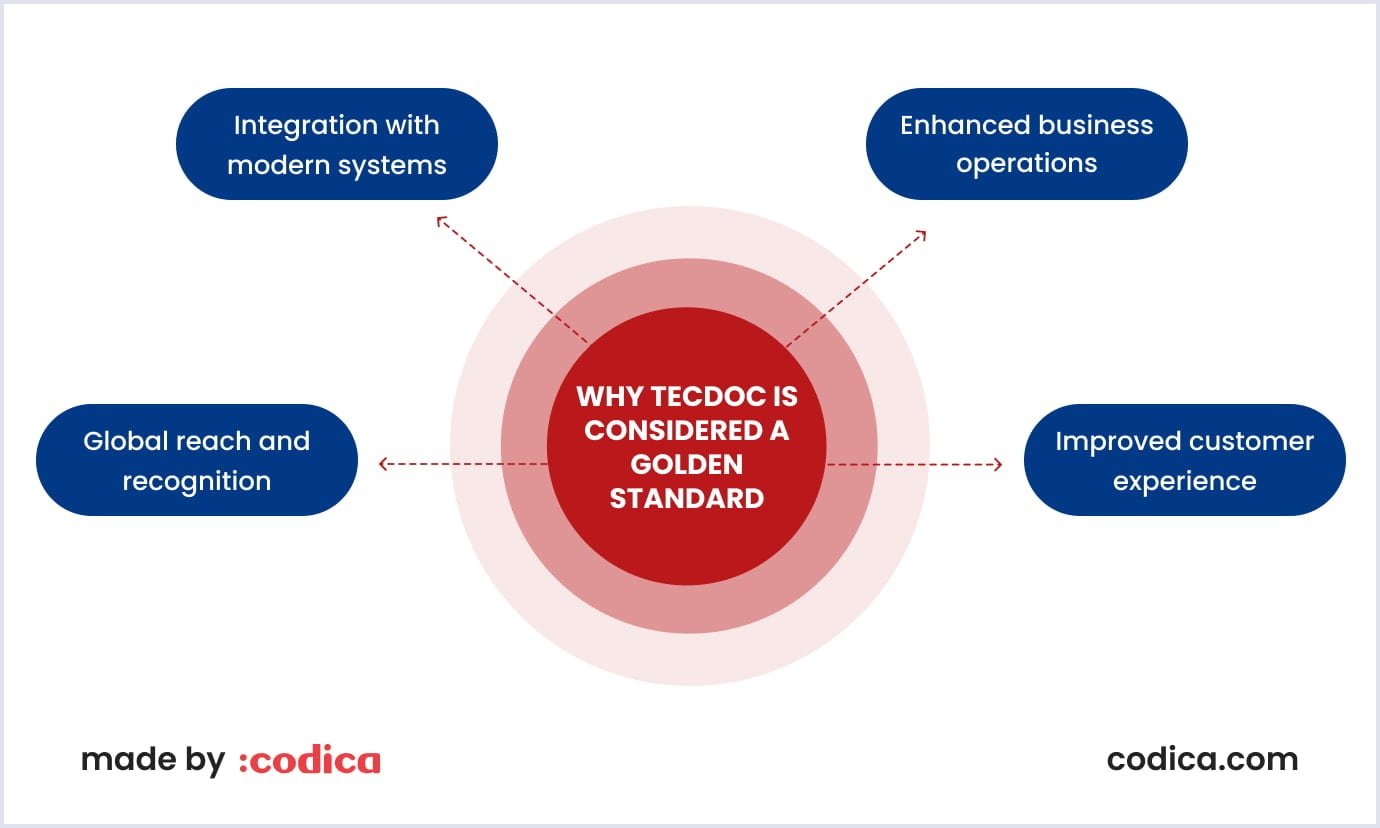
- Enhanced business operations. For distributors and retailers, TecDoc provides a consolidated source of precise parts information, streamlines inventory management, lowers order processing mistakes, and expedites delivery times.
- Improved customer experience. Customers benefit from faster searches, precise compatibility results, and fewer returns due to mismatched parts. This reliability fosters trust and loyalty.
- Global reach and recognition. TecDoc’s adoption across multiple countries and industries makes it a universal standard, enabling businesses to operate seamlessly in international markets.
- Integration with modern systems. Many ERP, CRM, and ecommerce platforms integrate with TecDoc, allowing businesses to streamline operations and provide customers with a seamless shopping experience.
Key features for a TecDoc-integrated auto parts marketplace
TecDoc does a great job shaping your marketplace with solutions and features suitable specifically for the auto parts niche. Here are features you can expect by integrating it into your solution.
Advanced search and filtering options
A TecDoc auto parts marketplace must offer robust search and filtering tools that allow users to navigate vast inventories seamlessly. With TecDoc’s structured data, you can create functionality to:
- Search by vehicle specifications;
- Filter by part category, brand, price range, and availability;
- Cross-reference part numbers to ensure accurate matches;
- Support both novice users and professionals, making the platform intuitive for all.
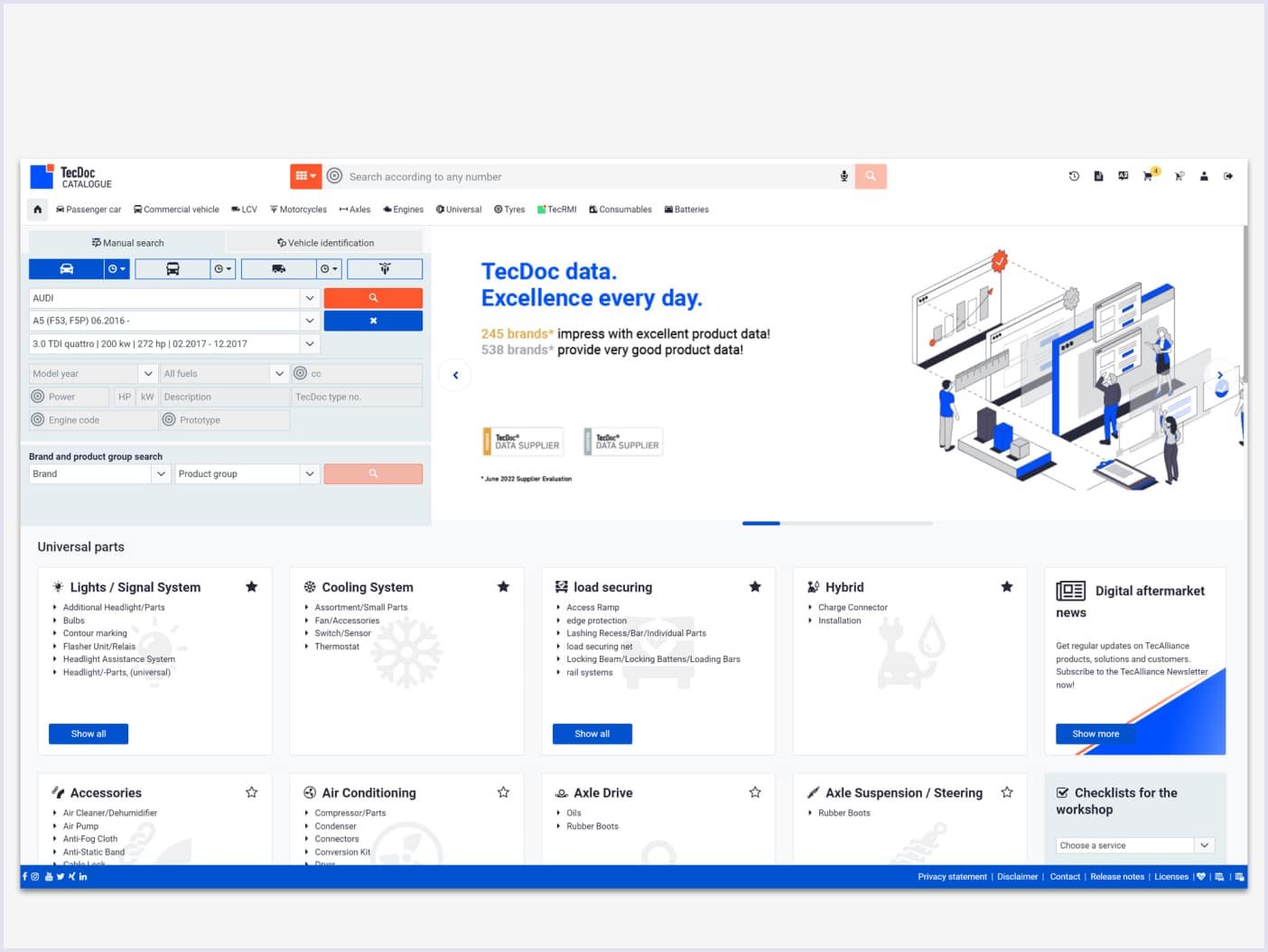
Source: TecAlliance
Multi-language and regional support
TecDoc's extensive database supports numerous languages and has region-specific information. Therefore, it is super suitable for marketplaces operating worldwide. Prioritize the following features:
- Interface options in many languages for consumers from other countries;
- Localization of compatibility standards, measurements, and part descriptions;
- Currency and delivery choices can be customized for each region.
Compatibility checker for vehicle parts
The auto parts compatibility checker tool is one of the most notable capabilities made possible by TecDoc. Customers can use this function to find parts that are particularly made for their vehicles by:
- Enter the vehicle's information, including its year, make, model, and engine type;
- Get real-time part compatibility validation using the TecDoc database;
- Prevent buying parts that are incompatible or improper, which will drastically cut down on returns and complaints.
Real-time data synchronization
For a marketplace to stay competitive and trustworthy, accurate and up-to-date information is crucial. TecDoc integration facilitates real-time data updates, ensuring:
- Inventory levels reflect actual stock availability;
- Product details and compatibility information remain current;
- Vendors can manage listings effectively without manual updates;
- Customers avoid frustrations caused by outdated or inaccurate information.
A step-by-step guide to integrating TecDoc into an auto parts marketplace
At Codica, we have experience not only with marketplace development but specifically with TecDoc. We implemented it in a multi-vendor online vehicle marketplace, and here’s a breakdown of the most essential steps of setting up a TecDoc for a similar marketplace.
Step 1: Setting up TecDoc API access
The first step is TecDoc API setup, which serves as the gateway to its comprehensive data.
You start by registering with TecDoc or your TecAlliance partner to obtain your API credentials. Once you have your API key and access token, configure them in your application’s environment to establish secure communication with the TecDoc server.
After configuring your API, test the connectivity using tools like Postman or similar platforms. These tools allow you to verify that your marketplace can retrieve data correctly from TecDoc.
Once the API is functional, you’ll need to implement a system to fetch data regularly. This can be achieved by setting up a cron job or scheduled tasks to ensure your marketplace stays updated with the latest information, minimizing discrepancies and ensuring accuracy.

Step 2: Configuring the compatibility database
You will need to import and arrange the vehicle makes, models, and engine types data that TecDoc supplies within your marketplace platform. For instance, every car should be associated with particular types of components, such suspension, brakes, or engines.
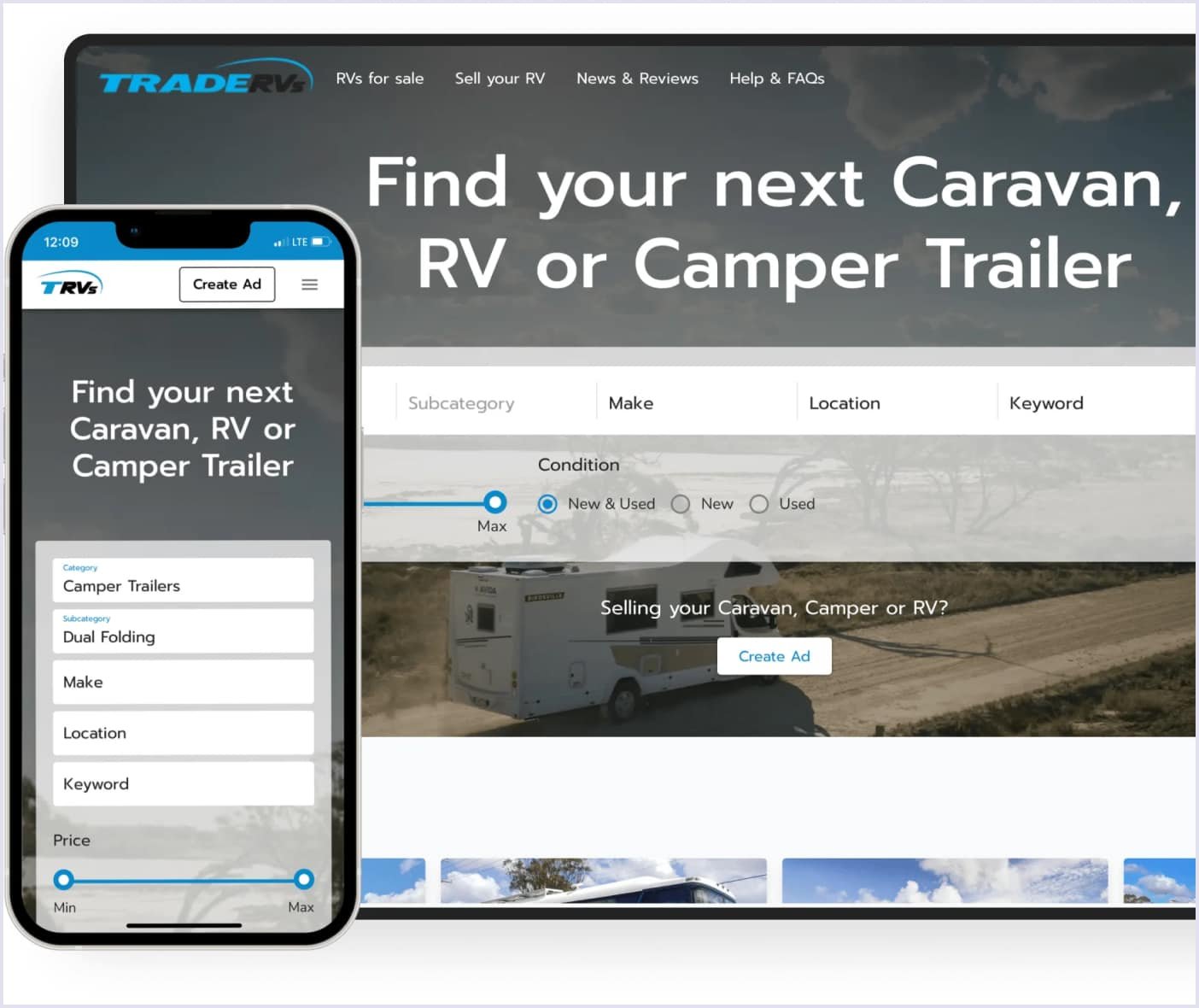
It's also critical to consider geographical requirements. The specifications of cars in Europe could differ from those in Asia or North America, therefore, your compatibility database needs to account for these differences.
Also, indexing the compatibility data helps you ensure that the marketplace can cater to all users and process their input. Caching data can improve performance even more and ultimately make results faster and the user experience smoother.
Step 3: Implementing search and filtering features
The next step is to use the structured data from TecDoc to build a powerful search and filtering tool. It should be easy for your customers to find parts in your store, even if they know little about the topic.
The first thing you should do is add a search engine that works with both single keywords and groups of keywords. For instance, autocorrect and predictive text features can help lead users to the right goods and make your marketplace even more user-oriented.
Filters are equally important. There are a bunch you can choose from, as they are based on vehicle details, its make, model, and year, alongside product-specific attributes like brand, material, or dimensions.
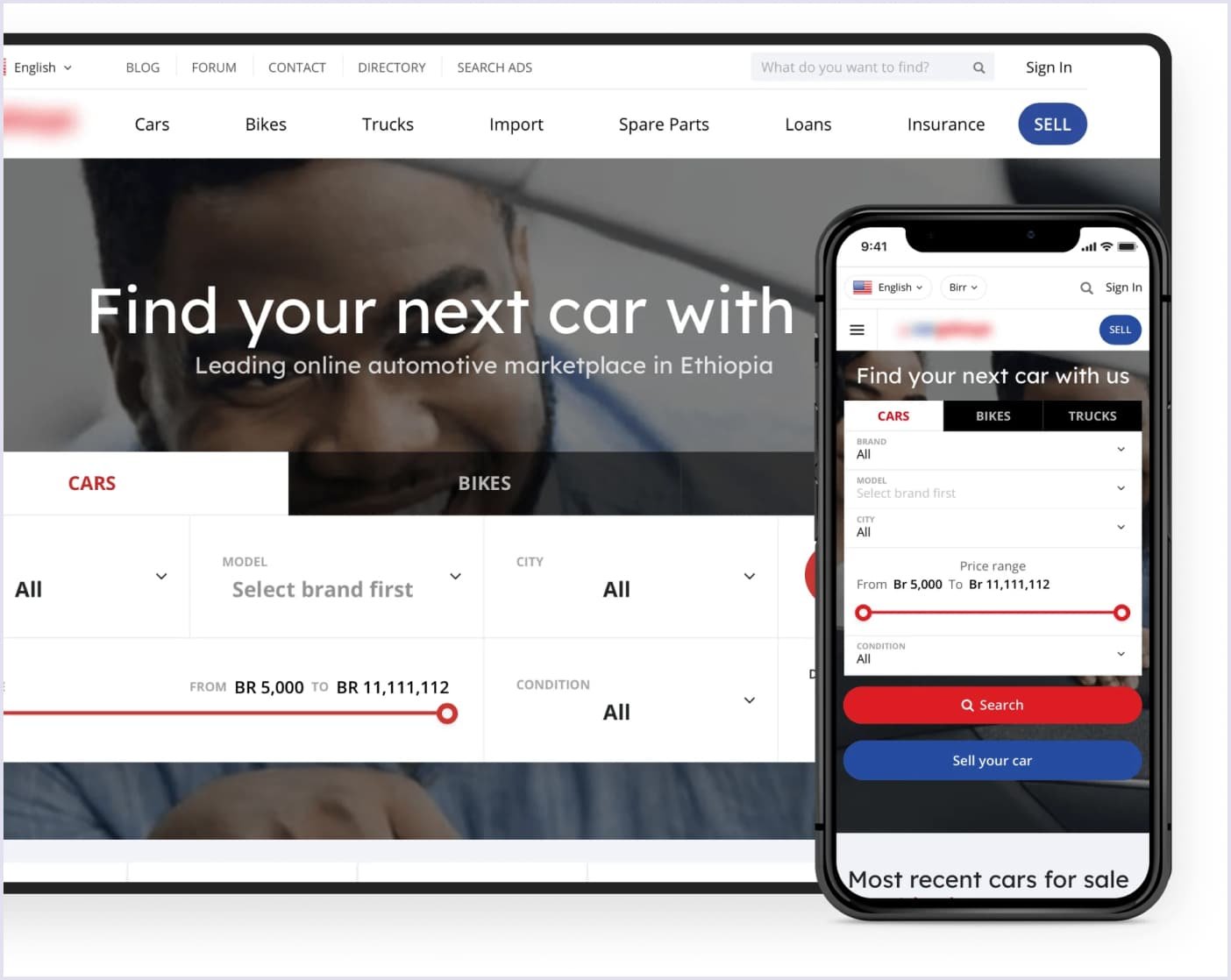
Ensure that search results are checked against TecDoc's compatibility data to eliminate mismatches that can cause customer annoyance. This process both improves the UX and reduces the number of returns due to improper purchases.
Step 4: Syncing real-time inventory data
TecDoc's auto parts marketplace API lets you add real-time updates to your inventory from your warehouse or suppliers. You can avoid overselling or listing items that are out of stock this way, and your marketplace will always show the most up-to-date stock amounts.
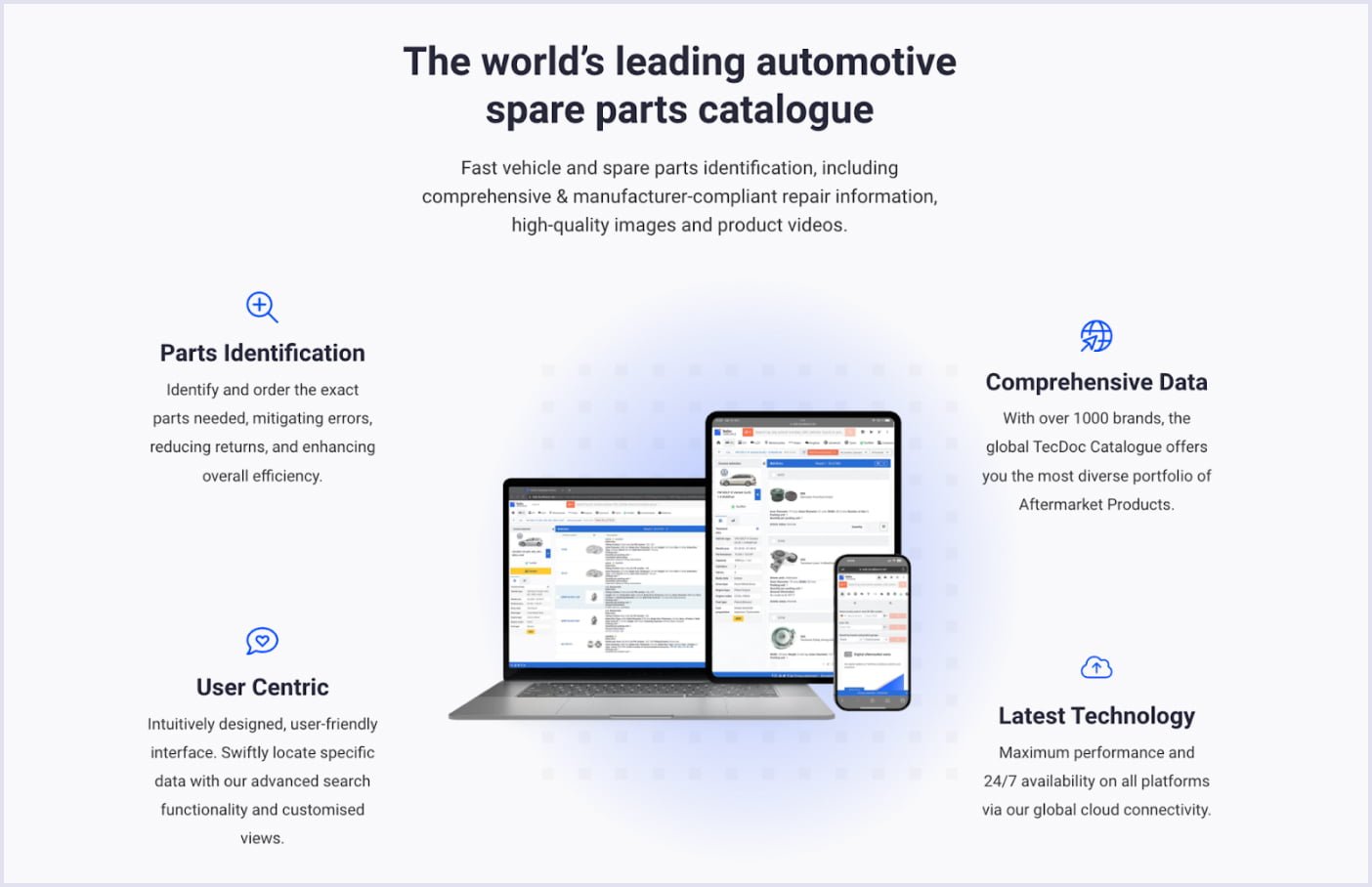
Source: TecAlliance
Automating the synchronization of supplies is the key to being efficient. Set up routine updates to keep track of stock amounts, availability, and when you expect to get more supplies.
Your system should quickly change the product listing to show any items that aren't available by either marking them as "out of stock" or hiding them.
Add features that let customers know when products they wishlist are refilled to keep them excited and likely to come back.
Step 5: Customizing frontend with TecDoc data
Lastly, the frontend of your marketplace should be made to use the TecDoc data in the best way possible. Start by adding a vehicle selection tool that lets buyers choose the make, model, and year of their car. This information can be saved in presets to make future shopping sessions even easier for them.
Normally, your ideal product listing should include all TecDoc's thorough information. Along with information, make sure to include compatibility info and high-quality images. Draw attention to important features like OEM numbers to reassure customers that the product is real.
You might also want to include visual tools like 3D models or part diagrams that can help customers understand how the product fits into their car.
Add small but useful auto parts ecommerce features features to your marketplace. For example, compatibility icons that make things clear right away or tooltips for hard words to make it even easier for people to use.
These parts give users more faith in your site and make the buying process easier.

Benefits of seamless TecDoc integration for an auto parts marketplace
Seamlessly integrating TecDoc into an auto parts marketplace offers numerous advantages for businesses and customers alike.
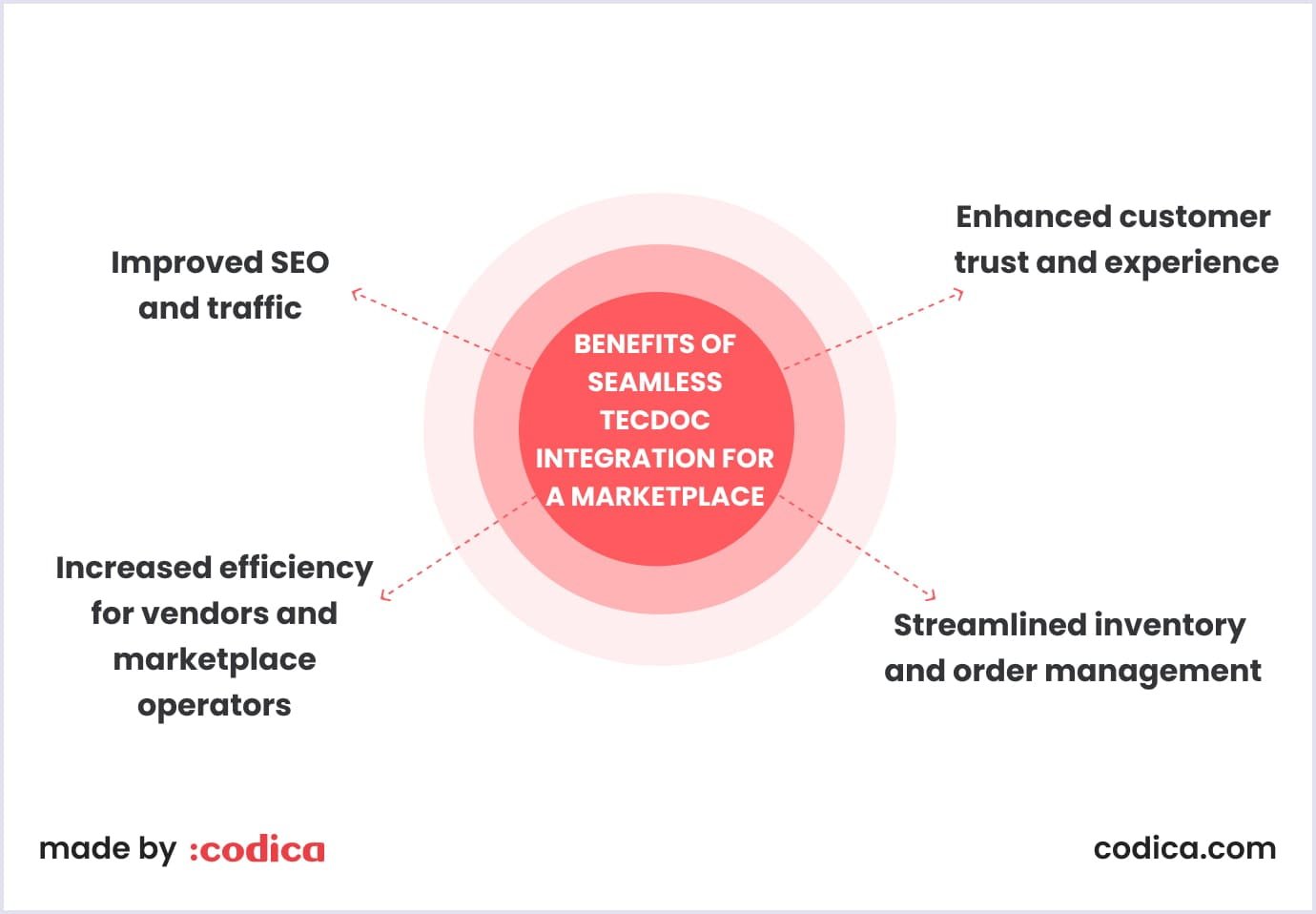
Enhanced customer trust and experience
Making sure that the parts will work with their car is a big problem for people who want to buy car parts. TecDoc addresses this problem by giving accurate and complete information on compatibility.
When customers know they can find parts that will fit their car, your marketplace gains more traction and trust. The more you work in this direction, the fewer product returns you will face and even fewer unhappy customers. The results are stronger company loyalty and a better experience for customers.
Increased efficiency for vendors and marketplace operators
Managing large product catalogs manually is time-consuming. The TecDoc integration automates product data management as it retrieves correct, standardized information directly from the database.
As a result, suppliers save time by not having to enter and check product information, while operators profit from a more structured and professional marketplace.
Streamlined inventory and order management
Thanks to TecDoc's real-time synchronization features, orders and stock amounts are always up to date. This feature helps sellers and marketplace owners avoid some of the most common issues. They often include overselling products or running out of stock on items that are trending and popular.
In the aftermath, you can greatly improve marketplace effectiveness with accurate records of your inventory and orders. Consequently, this will lead to faster delivery times and happier customers.
Improved SEO and traffic
As a marketplace owner, you know how online discoverability is critical. Well, TecDoc can improve that with detailed metadata, specifications, compatibility, and images. All these aspects can be SEO optimized, meaning that your marketplace regularly appears in search results.
This helps customers find the exact parts they need and improves the marketplace’s discoverability. Search engines prefer detailed and well-structured content, driving more organic traffic to the marketplace. Over time, this improved visibility attracts a larger audience and boosts sales potential.
Overcoming common challenges with TecDoc integration
Just like with any piece of software, you can face some challenges regarding implementation. Here are the most common issues business owners face.
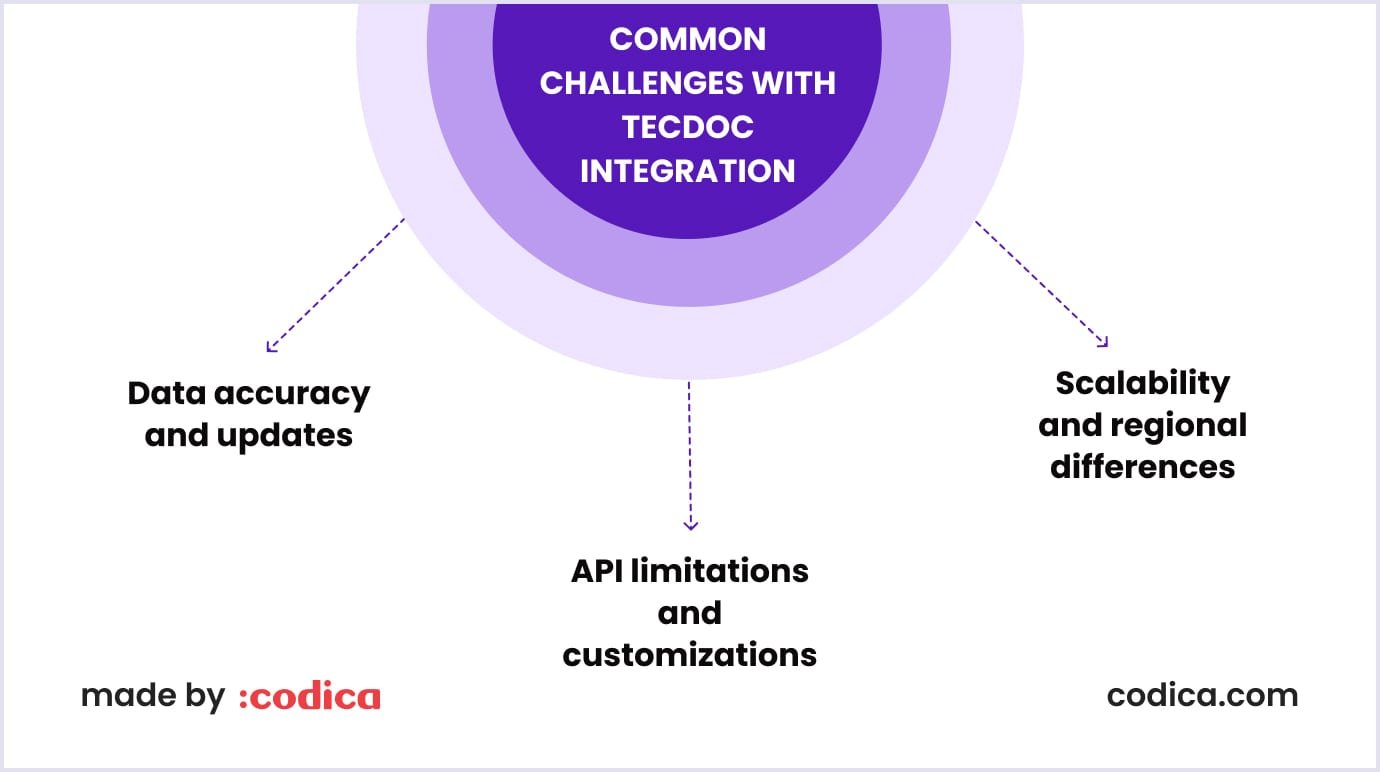
Data accuracy and updates
Maintaining accurate and up-to-date data from the TecDoc database can be difficult due to the large volumes of information and the dynamic nature of auto parts catalogs. So, how do you tackle this?
There are several solutions.
Firstly, run frequent API checks. Set up regular health checks for API connections. This way, you will make sure the data flow between the TecDoc database and the marketplace is accurate, secure, and always up-to-date.
Second, automate routine processes. With properly set up automations, you can greatly reduce the manpower needed to handle various tasks. These, for example, are inventory synchronization, auto part descriptions, and compatibility information.
Finally, come up with a system to respond to errors. Implement error recording and notification systems to discover and resolve data discrepancies quickly. You and your team should always have a plan for handling various issues.
API limitations and customizations
TecDoc’s APIs may not fully cover your venture’s unique requirements. Therefore, some compatibility issues may arise.
Here’s how you deal with it.
Create custom configurations. You can adjust API endpoints to your specific marketplace needs like filtering by regional availability or supporting unique search parameters.
Use third-party tools. Use middleware or third-party API management tools to enhance TecDoc’s integration capabilities and extend its functionality.
Engage in collaborative partnerships. Work closely with TecDoc’s support team to address specific customization requests and resolve limitations effectively.
Scalability and regional differences
As your marketplace grows, scaling TecDoc integration and addressing region-specific auto parts demands become increasingly complex.
To deal with these issues, you can:
Make your architecture scalable. Design the marketplace infrastructure to handle increased data volume and traffic, ensuring smooth performance even during peak demand.
Add more localization features. Implement region-specific customizations, such as localized part names, measurements, and currency options, to cater to different markets.
Make use of demand analytics. Use data analytics to identify regional trends and adjust TecDoc configurations to prioritize high-demand parts.
Conclusion
In the aftermath, TecDoc is not simply an advisable tool for any auto parts marketplace. On the contrary, it is practically a must-have integration if you’re looking to settle in the industry and make a successful marketplace.
Therefore, feel free to contact us so we can implement it in your marketplace. Additionally, refer to our blog to learn more about the ways we work with marketplaces, SaaS, AI, and MVP development services.
